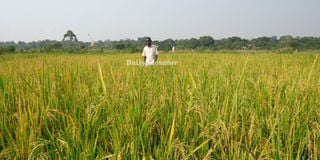New rice seed promises high yields, income

A farmers stands in his rice field. High yielding varieties such as Green Super Rice would help boost his productivity. PHOTO BY FRED MUZAALE
New rice varieties that will enable growing of the crop with less pesticides, less fertilizers and less water have showed yields of 20-30 times more than traditional ones under trials on farmers’ fields.
Farmers in eastern and northern Uganda received Green Super Rice (GSR) seed for the research trials.
Jackson Atwii, a retired rice agronomist at Kibimba Rice Irrigation Scheme in Bugiri district, and other farmers in Olweny Rice Irrigation Scheme in Lira District, confirmed the excellent field performance.
“This project began in 2012, with a target of an expected yield-advantage of 20 per cent. During 2015, country-specific objectives in Uganda included testing and release of new GSR varieties in different stress conditions in atleast four locations (Doho in Butaleja District, Agoro in Amuru District, Olweny in Lira District and Oyam District,” said Dr Jimmy Lamo, who heads rice research at National Crops Resources Research Institute (NaCRRI).
Bigger grains
Semmy Opio and her husband, Dr. Patrick Opio, a medical practitioner in Lira Municipality, received four kilos of GSR seed last year, and harvested 10 bags (1,000 kgs) of the 1189 rice variety alone.
The couple and several other farmers have bulked harvested seed from the 2015 planting. “My wife used to grow rice on subsistence basis to harvest a little for food, but when Mr Atwii interested us in growing GSR varieties for seed, we agreed and it has been a pleasant surprise,” said Dr Opio.
They grow seed rice on 2.5 acres in Olweny Rice Irrigation Scheme, where they planted three GSR seed varieties: Namulonge muchele (NamChe)-3, TXD306 and 1189.
Semmy says the four kilos of NamChe-3 seed alone yielded 10 sacks at harvest equaling to a tonne. “Namche-3 grains are bigger than TXD306 and 1189 varieties, and we believe we would grow it two to three times a year,” she says.
Farmer-leader, Atwii says a number of farmers whom he guides on growing, weeding, and post-harvest management, have registered substantial success.
“We have learnt that to make any meaningful sense from this project, yields must be high. And that’s what every body sees,” he says.
Howard Ogwang, is another farmer in Itek-kile Outgrowers’ Community in Lira District, guided by Mzee Atwii.
He received two kilos of a different rice seed variety: 1191, planted it in nursery beds, transferred into fields and harvested 130 kgs of seed alone.
In neighbouring Oyam District, the lead farmer Paul Peter Okullu, the managing director, Adagni Company Ltd, received 75 kgs of NamChe-1 and 3 seed from NaCRRI in 2014.
He distributed it through a technology-dissemination arrangement, to 50 seed farmers.
“They collectively harvested five tonnes of NamChe-1 and 3 seed varieties that year. In 2015, we expanded to seven acres, from which we harvested 12 tonnes,” he adds.
“Seed production is more lucrative than grain or food growing/trading. In 2015’s first season, we gave back five tonnes of seed to NaCRRI.”
In Doho Scheme, farmers and farmer groups were trained about GSR seed and provided with one to 10 kilogrammes of seed.
The scheme was the first to get the training and seed distribution. It was planned that there would be field seed exchange among farmers, in addition to linking them to NaCRRI’s partners from which farmers and farmer groups would buy seed.
Wonderful performance
Those with the best field performance and with best-inspected seed would be encouraged to exchange seed with other farmers.
During the last quarter of the 2015 planting and harvest seasons (August-September-October), Doho outgrower farmers received GSR seed rice varieties: Okile, Wita-9, Komboka, Agaro and Nerica. There were good results from their findings.
A model rice farmer in Butaleja District located near Doho Scheme, Robert Sagula, refers to the Wita-9 purple variety as the most outstanding. It is currently the most widely-adopted by farmers, for its versatile performance.
He describes it as a wonderful performer in marginal soils even where fertility and water factors are low.
“It’s a highly sought-after variety by farmers, because it also registers the highest yield or productivity per unit area. We have recorded 2,150 kg of milled rice from an acre planted—very high compared to traditional varieties,” says Sagula.
He has grown it next to the road, as a public display to teach farmers and attract a market for its positive attributes.
“We also prefer it for its short height as birds cannot notice it easily, in addition for its long grain and being an early-maturing variety in 145 days after planting,” he explains.
Sagula reveals that Okile variety ranks second to Wita-9 in popularity in Butaleja, because of its high yields and good grain quality-attributes. It is close to Kaiso, a popular traditional variety, as far as the Butaleja farmers are concerned.
About the project
The GSR project is based at the National Crops Resources Research Institute (NaCRRI) in Namulonge.
It is being coordinated by the International Rice Research Institute (IRRI) in collaboration with AfricaRice, Chinese Academy of Agricultural Sciences (CAAS) and Agricultural Research Systems in Africa and Asia.
The main goal is to develop and deploy new sets of rice cultivars that give high yields under less input environments (that is, water, Nitrogen, Phosphorus and pesticides) in an environment-friendly manner.
It is supported by a grant from the Bill and Melinda Gates Foundation
NaCRRI’s Dr. Jimmy Lamo, who heads Uganda’s rice research, says in addition to Uganda, other participating countries in the GSR project, are China through CAAS, Tanzania, Mozambique, Rwanda, Ethiopia, Burundi and The Philippines.




